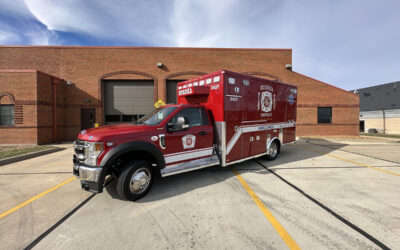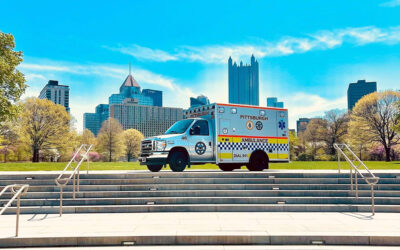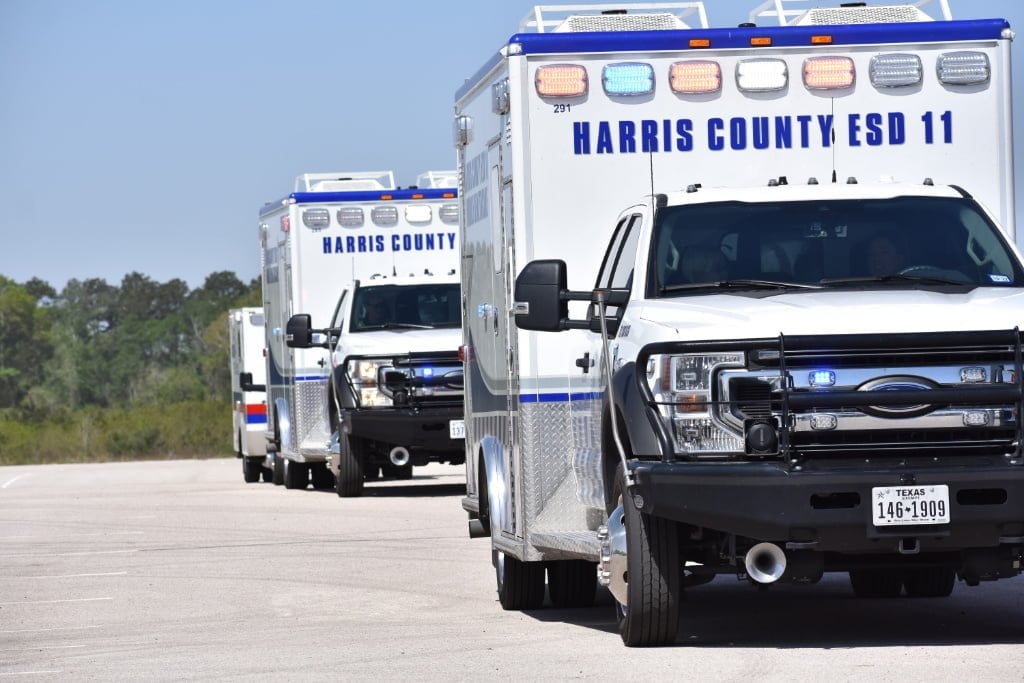
Harris County (TX) Emergency Services District 11 is operating up to 28 American Emergency Vehicles (AEV) Type 1 ambulances. (Photos courtesy of Harris County Emergency Services District 11.)
By Alan M. Petrillo
Harris County (TX) Emergency Services District (ESD) 11 is operating up to 28 American Emergency Vehicles (AEV) Type 1 ambulances during peak hours, rigs that had been delivered to the district in the past year. Harris County ESD 11 is a large emergency services district in Texas.
The AEV rigs are built on Ford F-450 chassis powered by a 7.3-liter Godzilla gasoline engine and a battery system, says Doug Hooten, Harris County ESD 11’s chief executive officer, which allows the rigs to operate on battery power while parked. This reduces fuel consumption, making the vehicle more environmentally friendly, and increases the ambulance’s lifespan. The overall length of the rigs is 26 feet, and the overall height is 10-feet 4-inches. Hooten points out that the Harris County ambulances run a total of 200 emergency medical services (EMS) calls per day.

The AEV rigs are built on Ford F-450 chassis powered by a 7.3-liter Godzilla gasoline engine and a battery system.
“Harris County ESD 11 took over EMS services in September of 2021 from a provider who did the service for 42 years,” Hooten says. “Our district was concerned about providing a high level of EMS coverage, as well as a high level of safety for our patients and medic personnel. We cover an area about the size of the city of Atlanta, Georgia, 177 square miles, providing service to a population of 700,000 people with 195 paramedics and EMTs (emergency medical technicians.)”
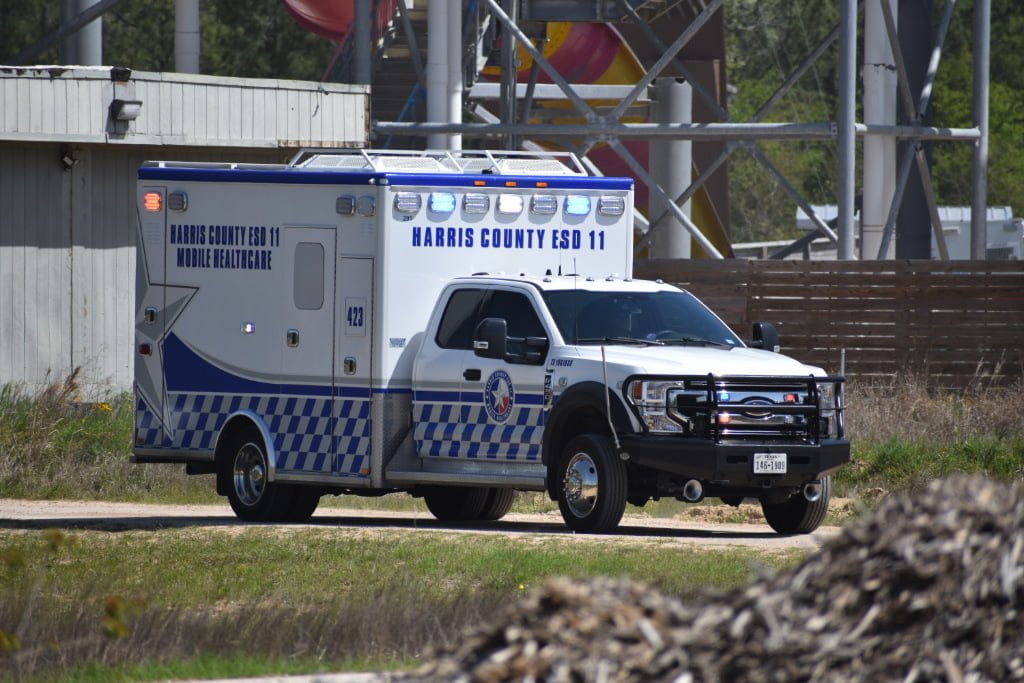
The ambulance has high-visibility exterior graphics that make the vehicles easier to see in the dark.
Hooten notes that the AEV Type 1 ambulances have the REV Group’s Per4Max four point seat harness system built into each seat, a Stryker PowerLOAD system and PowerPRO XT cot that help prevent back injuries to medics loading and unloading patients, extra workspace inside the patient module to allow paramedics and EMTs to safely care for their patients, and high-visibility exterior graphics that make the vehicles easier to see in the dark.

A medic removes a Stryker PowerPRO XT cot from the back of one of the AEV rigs.
Shel McClendon, Harris County ESD 11’s risk and safety manager, says the design and robust structure of the AEV ambulances recently was highlighted when one of the rigs that had stopped for a red light was rear-ended by a Nissan SUV. “Our staff had a patient loaded in the rear module on a non-emergency transport to a hospital,” McClendon says. “The ambulance was rear-ended by a SUV doing about 70 to 80 miles per hour, which jammed the front of the SUV under the rear of the ambulance. The SUV’s airbags deployed, and the driver needed to be extricated.”
McClendon notes that when the SUV struck the ambulance, the paramedic driving the rig only felt a vibration. “The patient and the paramedic in the rear were uninjured, there were no leaks in the ambulance, and there was no intrusion into the patient box, only a collapsed bumper,” he says. “Also, the right rear compartment was damaged by opening it up on the bottom.”
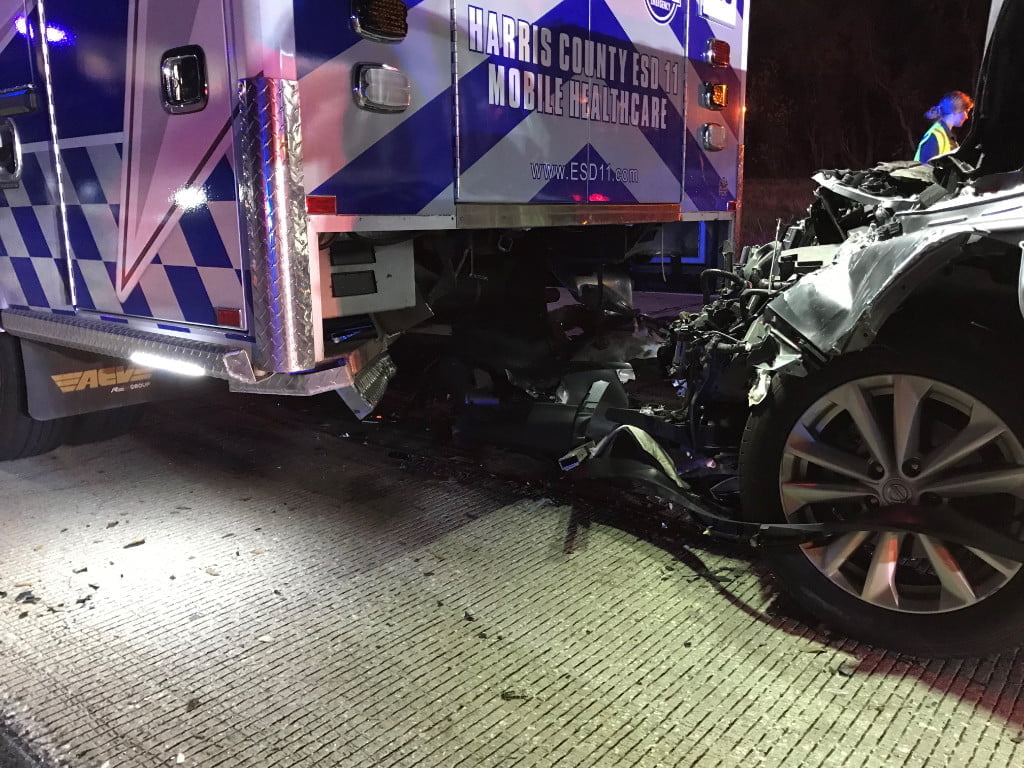
One of the new AEV ambulances was rear-ended by a SUV while at a stop light, but only suffered damage to the bumper and the bottom of the right rear compartment. No damage was found on the rest of the rig.
McClendon adds that the ambulance’s rear doors were fully operational after the crash and did not have any issues, the floor of the ambulance remained flat, and the Stryker stretcher functioned perfectly. “Everything was working well, even after being hit by a SUV traveling at the high rate of speed,” he says. “We are thoroughly impressed by AEV’s extruded aluminum build process, as opposed to formed aluminum construction.”
Related
Horton Emergency Vehicles Delivers Its 20,000th Ambulance to Franklin Township (OH) Fire Department
Harris County (TX) Emergency Services District 48 Receives Two Type 1 Wheeled Coach Ambulances
ALAN M. PETRILLO is a Tucson, Ariz.-based journalist, the author of three novels and five non-fiction books, and a member of the Fire Apparatus & Emergency Equipment editorial advisory board. He served 22 years with Verdoy (NY) Fire Department, including the position of chief.

